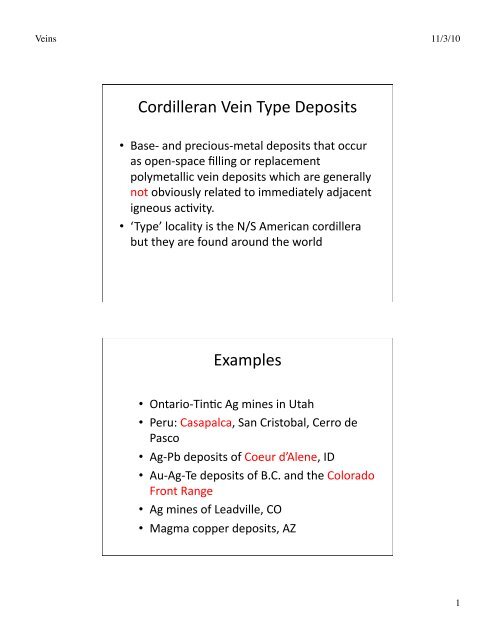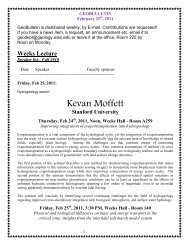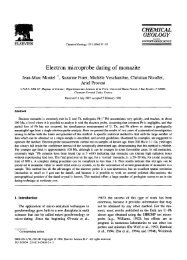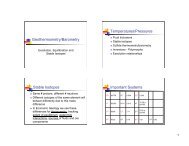Cordilleran Vein Type Deposits Examples
Cordilleran Vein Type Deposits Examples
Cordilleran Vein Type Deposits Examples
You also want an ePaper? Increase the reach of your titles
YUMPU automatically turns print PDFs into web optimized ePapers that Google loves.
<strong>Vein</strong>s 11/3/10<br />
<strong>Cordilleran</strong> <strong>Vein</strong> <strong>Type</strong> <strong>Deposits</strong><br />
• Base-‐ and precious-‐metal deposits that occur<br />
as open-‐space filling or replacement<br />
polymetallic vein deposits which are generally<br />
not obviously related to immediately adjacent<br />
igneous ac>vity.<br />
• ‘<strong>Type</strong>’ locality is the N/S American cordillera<br />
but they are found around the world<br />
<strong>Examples</strong><br />
• Ontario-‐Tin>c Ag mines in Utah<br />
• Peru: Casapalca, San Cristobal, Cerro de<br />
Pasco<br />
• Ag-‐Pb deposits of Coeur d’Alene, ID<br />
• Au-‐Ag-‐Te deposits of B.C. and the Colorado<br />
Front Range<br />
• Ag mines of Leadville, CO<br />
• Magma copper deposits, AZ<br />
1
<strong>Vein</strong>s 11/3/10<br />
Generaliza>ons -‐1<br />
• Associa>on in space and >me with calc-‐<br />
alkaline igneous ac>vity<br />
• Hydrothermal transport of ore components,<br />
deposited epigene>cally in faults<br />
• Ore minerals as typical open-‐space fillings<br />
or co-‐precipitates in silicate host rocks and<br />
as replacements in carbonate hosts<br />
• Deposi>on within 1+ km of the surface<br />
• Well developed metal zona>on<br />
Generaliza>ons-‐2<br />
• Sulfur isotope ra>os close to 0 ‰<br />
• Structural control<br />
• Typically well-‐developed bilaterally<br />
symmetrical wall-‐rock altera>on<br />
• Normally contain porphyry-‐Cu suite of<br />
elements with zona>on from (Sn-‐W-‐)Mo-‐<br />
Cu-‐Zn-‐Pb-‐Mn-‐Ag<br />
• Magma>c-‐hydrothermal fluids mixed (late,<br />
post-‐ore?) with meteoric fluids<br />
2
<strong>Vein</strong>s 11/3/10<br />
Casapalca, Peru<br />
3
<strong>Vein</strong>s 11/3/10<br />
Casapalca, Peru<br />
• Mineraliza>on in a series of veins<br />
• <strong>Vein</strong>s cut series of N-‐S an>clines and<br />
synclines in Cretaceous ls; 1500m of<br />
Ter>ary subaerial Casapalca Fm; 1500m of<br />
andesi>c tuffs, flows, and volcaniclas>c<br />
sediments and 1500m of pre-‐Miocene<br />
sediments and volcanic rocks<br />
• Principal C vein N45°E, dips 70-‐80 NW<br />
– Other veins subparallel; or as splays<br />
4
<strong>Vein</strong>s 11/3/10<br />
5
<strong>Vein</strong>s 11/3/10<br />
Casapalca Structures<br />
• Miocene folding and diori>c intrusions<br />
• Major intrusion cut by mineralized fault -‐<br />
complicated history<br />
• Liile skarn in district<br />
– Found in the 11km Graton Tunnel driven below<br />
the workings to drain water (up to 66°C),<br />
ven>late, haulage<br />
• <strong>Vein</strong>s occupy shear planes -‐ 6 km long, 2<br />
km high<br />
6
<strong>Vein</strong>s 11/3/10<br />
7
<strong>Vein</strong>s 11/3/10<br />
Timing, temperature, mineralogy,<br />
zona>on<br />
• See figure<br />
– Py-‐Sphalerite-‐Galena-‐(huebnerite-‐<br />
arsenopyrite) early at 350-‐400° C<br />
– Chalcopyrite, then Tetrahedrite follow, ZnS-‐PbS<br />
begin to wane<br />
– Pyrite and quartz gangue<br />
– Late sulfides strongly zoned: both<br />
mineralogically and composi>onally<br />
– Altera>on is extensive centrally becoming less<br />
intense and localized outward<br />
8
<strong>Vein</strong>s 11/3/10<br />
Timing, temperature, mineralogy,<br />
zona>on (cont.)<br />
• Chalcopyrite abundant in center, Sb-‐As-‐Bi<br />
sulfosalts take over peripherally<br />
• 4-‐40% NaCl, varied erra>cally, minor boil<br />
• Average ore grade:<br />
– 2% Pb 3% Zn<br />
– 0.3% Cu 10 oz/ton (310 ppm) Ag<br />
• <strong>Vein</strong>s up to 1 meter wide<br />
– Important small adjacent parallel fractures<br />
9
<strong>Vein</strong>s 11/3/10<br />
10
<strong>Vein</strong>s 11/3/10<br />
Cerro de Pasco, Peru<br />
Buie, Montana<br />
11
<strong>Vein</strong>s 11/3/10<br />
Colorado Telluride Belt<br />
• NE end of the Colorado Mineral Belt<br />
• Placer gold discovered in 1859<br />
• Au-‐Te ores discovered in 1872<br />
• Small, erra>cally distributed, rich ore bodies<br />
• Mined un>l about 1960<br />
• Te not recovered from these ores -‐ Te<br />
recovered during Cu refining (porphyries)<br />
12
<strong>Vein</strong>s 11/3/10<br />
Geologic Seong<br />
• Precambrian schist and gneiss intruded by<br />
Ter>ary stocks & dikes<br />
• Te mineraliza>on related to dikes and<br />
intrusion breccias<br />
• Localized where NW ‘breccia reefs’ intersect<br />
NE veins<br />
13
<strong>Vein</strong>s 11/3/10<br />
14
<strong>Vein</strong>s 11/3/10<br />
Ore <strong>Deposits</strong> -‐ Mul>ple Events<br />
• Pb-‐Ag deposits: widely scaiered veins (NE)<br />
– (Pb,Ag)S, tetrahedrite, ± sph, cpy, py<br />
• Fluorite deposits: Jamestown<br />
– 1-‐20’ wide veins, 100-‐1000’ long<br />
– Adjacent to sodic grani>c stocks<br />
– Deep violet color: up to 0.05% U<br />
• Pyri>c Au deposits: NE trending veins<br />
– Coarse pyrite, cpy, sph, gal, tetrahedrite<br />
– Earlier than Au-‐Te event<br />
Mul>ple Events -‐ con>nued<br />
• Au-‐Te deposits: NE trending fissures<br />
– Inches to feet thick, mined to 3-‐700’ depth<br />
– Ore con>nues at depth but water and Au price<br />
made non-‐economic<br />
– Best ore in breccia zones<br />
– Petzite, hessite, sylvanite, calaverite, …<br />
• Tungsten deposits: E-‐NE belt overlapping<br />
end of Te belt<br />
– Fe-‐Mn tungstates (ferberite)<br />
15
<strong>Vein</strong>s 11/3/10<br />
16
<strong>Vein</strong>s 11/3/10<br />
Coeur D’Alene, Idaho<br />
• One of the largest Ag districts in the world<br />
• $3+ billion of ore since 1879<br />
– 1 billion oz of Ag<br />
– 10 million tonnes of Pb<br />
– 3 million tonnes of Zn<br />
– 200,000 tonnes of Cu<br />
– Significant Sb<br />
17
<strong>Vein</strong>s 11/3/10<br />
• 50 x 20 km area<br />
• District-‐wide zoning<br />
– Au in north<br />
– Pb-‐Zn in center<br />
– Cu-‐Ag in south<br />
• Underlain by:<br />
General Seong<br />
– Proterozoic Belt Group<br />
– Cretaceous igneous intrusions<br />
– Ter>ary and Quaternary unconsolidated units<br />
Belt Group<br />
• Quartzites, argillites and calcareous rocks<br />
up to 6km thick<br />
• Shallow water origin<br />
– Mud cracks, ripples, stromatolites<br />
• Folded, faulted and minor metamorphism<br />
in Proterozoic and during Laramide<br />
– Monzonite stocks and lamprophyre dikes and<br />
sills were intruded aver Mesozoic deforma>on<br />
– Minor diabase sills appear to be Precambrian<br />
18
<strong>Vein</strong>s 11/3/10<br />
Faul>ng<br />
• WNW faults, the major being:<br />
• Osburn Fault can be traced for hundreds of<br />
kms outside of district<br />
– Dips 55-‐65° south<br />
– 4.5 km normal dip-‐slip offset<br />
– 25 km right lateral strike slip displacement<br />
– Intermiiently ac>ve since Precambrian<br />
– 30-‐60 m wide fault zone<br />
– Many parallel and oblique 2nd order faults<br />
19
<strong>Vein</strong>s 11/3/10<br />
Ore deposits<br />
• Most in fractures and shears in Belt rocks<br />
– Minor structures more favorable than major<br />
• Some ore in monzonites, lamprophyres<br />
unmineralized<br />
• Briile rocks more highly mineralized<br />
• Galena, sphalerite, tetrahedrite,<br />
chalcopyrite, pyrrho>te, magne>te,<br />
arsenopyrite<br />
– Minor bornite, chalcocite, s>bnite, Cu-‐Sb-‐S<br />
sulfosalts, scheelite, uraninite<br />
Ores (cont)<br />
• Arsenopyrite forms envelopes around ore<br />
• Qtz, siderite, pyrite, (barite) as gangue<br />
– Typical ‘mesothermal’ assemblage<br />
• 10% combined Pb-‐Zn; 1 oz/tonne Ag<br />
• Ag in tetrahedrite, not galena<br />
20
<strong>Vein</strong>s 11/3/10<br />
Timing or Mineraliza>on<br />
• Very confusing and s>ll debated<br />
– Some may be Precambrian<br />
– Most probably syn-‐ post-‐Laramide<br />
– Some stocks seem directly implicated<br />
– Pb age is Precambrian -‐ remobilized from Belt<br />
basement by Laramide hydrothermal systems?<br />
– No single paragenesis for district as whole<br />
– Altera>on variable -‐ sericite most common<br />
Cobalt, Ont. Loca>on Map<br />
21
<strong>Vein</strong>s 11/3/10<br />
Cobalt, Ontario -‐ Summary 1<br />
• 445 million oz Ag since 1903<br />
• Na>ve Ag w/ cobalt arsenides and sulfosalts<br />
• Near ver>cal carbonate veins cuong<br />
– Huronian Gowganda<br />
– Archean metavolcanics<br />
– Nipissing diabase<br />
• All major deposits within a few hundred<br />
meters of the Archean unconformity and in<br />
proximity to diabase and VMS sulfide<br />
mounds in the Archean metavolcanics<br />
22
<strong>Vein</strong>s 11/3/10<br />
Cobalt, Ontario -‐ Summary 2<br />
• Ag mobilized from country rocks by<br />
hypersaline brines and deposited by mixing<br />
with cooler meteoric water<br />
• Chloride complexing dominant<br />
• Halite-‐bearing fluid inclusions<br />
• 300-‐350° C<br />
• 600-‐1360 bars (2-‐4 km lithosta>c depth)<br />
23





